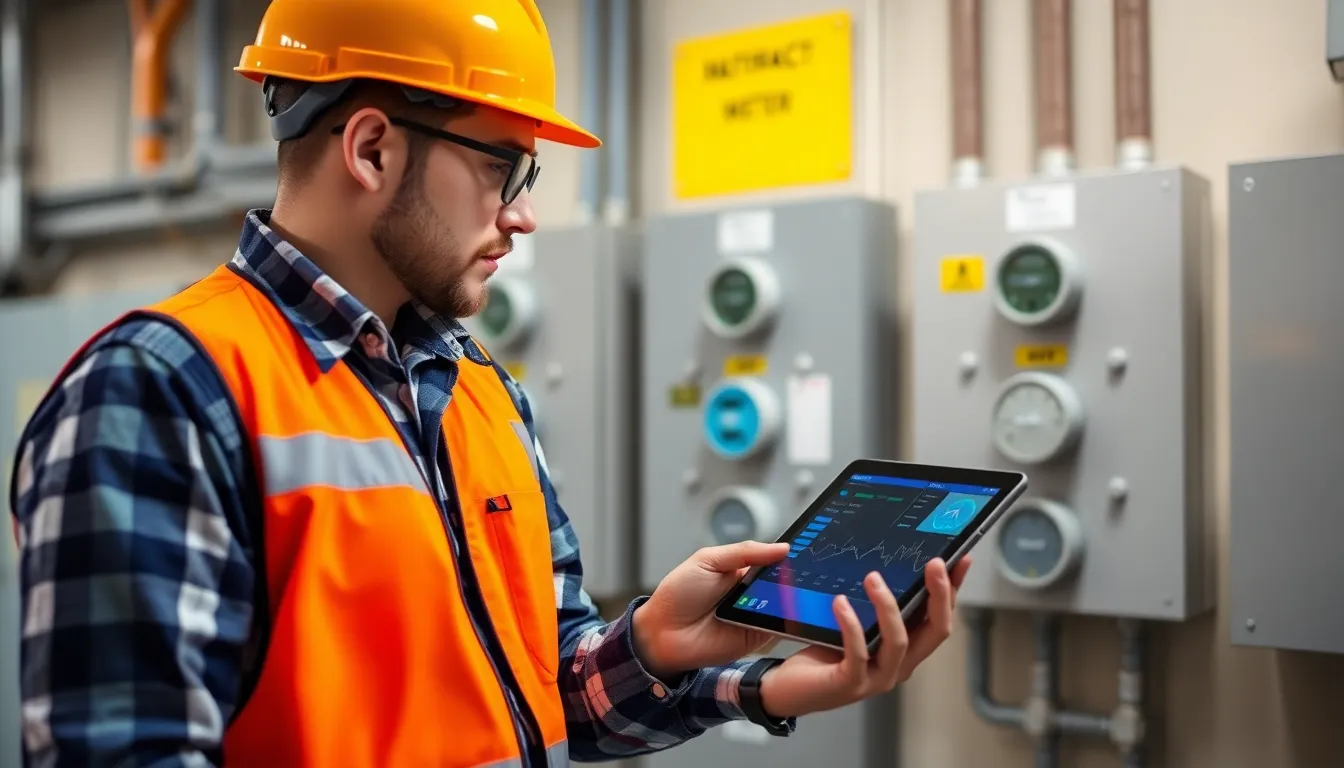Imagine a world where your toaster knows exactly how brown you like your bread, and your thermostat can predict the weather better than your local news station. Welcome to the Internet of Things (IoT) utilities—where everyday objects become smart, connected, and surprisingly chatty. This isn’t just science fiction; it’s the future of how we manage energy, water, and even waste.
As cities evolve into smart hubs, IoT utilities are revolutionizing the way people interact with their environment. From reducing energy consumption to optimizing water usage, these technologies don’t just save money—they save the planet too. So, buckle up and get ready to explore how these nifty innovations are transforming mundane utilities into a seamless, efficient experience that even your grandma would approve of.
Table of Contents
ToggleOverview of Internet of Things Utilities
The Internet of Things (IoT) revolutionizes traditional utilities by transforming them into smart, connected systems. Smart devices enhance operational efficiency in energy, water, and waste management sectors. These connected devices collect real-time data, enabling proactive responses to consumption patterns.
Smart meters exemplify this transformation in energy management. They provide immediate feedback on electricity usage, helping users adjust their habits for optimal efficiency. Water utilities utilize IoT sensors to monitor leaks and pressure changes, prompting timely maintenance and reducing waste.
Waste management also benefits from IoT innovations. Smart bins signal when they’re full, optimizing collection routes and minimizing operational costs. This approach reduces carbon footprints as trucks travel fewer miles.
Integrating IoT technologies fosters greater environmental sustainability. Cities leveraging IoT utilities report noticeable decreases in energy usage and water consumption. Additionally, data analytics enable personalized energy solutions for consumers, enhancing engagement with their utilities.
Future developments promise even more advancements in IoT utilities. As technology evolves, the integration of artificial intelligence (AI) with IoT systems could lead to self-optimizing utilities, further maximizing efficiency. With ongoing changes, the potential for smart cities continues to expand, creating new ways for residents to interact with their environment.
Ultimately, IoT utilities represent a significant step towards modernizing infrastructure. Each innovation contributes to building sustainable communities and enhancing the quality of life for individuals.
Benefits of Internet of Things Utilities

The implementation of Internet of Things (IoT) utilities brings several distinct advantages that enhance operational performance and user interaction.
Increased Efficiency
IoT utilities streamline operations by facilitating real-time data collection. Smart meters gather accurate electricity consumption data, allowing for immediate adjustments. Sensors in water management systems detect leaks, which minimizes water loss and reduces maintenance costs. Waste management utilizes smart bins to adjust collection schedules based on current fill levels. These adaptive approaches lead to significant savings in both time and resources. Operational resources get optimized, contributing to reduced energy consumption across the board. Ultimately, incorporating IoT technologies transforms traditional utility models into efficient, responsive systems that meet modern demands.
Enhanced Customer Experience
Grasping real-time insights into usage empowers consumers to make informed choices. IoT utilities enable users to monitor energy and water consumption through interactive dashboards. Customer engagement improves when companies provide personalized notifications based on usage patterns and trends. Faster response times become a reality as utilities leverage data analytics for proactive maintenance. Bill accuracy increases due to precise monitoring, leading to fewer disputes. Ultimately, IoT enhances overall satisfaction, fostering a stronger relationship between utility providers and customers.
Key Technologies Involved
IoT utilities rely on various key technologies that enhance operational efficiency and sustainability. These technologies include sensors, devices, and connectivity solutions.
Sensors and Devices
Sensors and devices play a crucial role in IoT utilities by collecting real-time data. Smart meters capture electricity and water consumption details accurately, allowing for immediate analysis. Water quality sensors monitor parameters like pH and turbidity, ensuring safe water supply. Smart thermostats optimize heating and cooling in buildings, reducing energy waste. In waste management, smart bins track fill levels, informing collection schedules. Each device contributes to a responsive system that addresses the needs of utilities and consumers.
Connectivity Solutions
Connectivity solutions enable seamless communication between devices and centralized systems. Wireless technologies, such as Wi-Fi and LoRaWAN, provide robust networks for data transmission. Cellular networks offer reliable coverage for remote locations, ensuring that devices remain connected. Cloud computing facilitates data storage and analysis, providing insights to utility providers. Integration of edge computing enhances response times by processing data closer to its source. These solutions together create a cohesive ecosystem that supports efficient utility management and improved customer experiences.
Applications of Internet of Things Utilities
IoT utilities significantly enhance various operational areas within modern infrastructure. They facilitate intelligent interactions and promote efficiency across energy, water, and waste management.
Smart Meters
Smart meters play a crucial role in IoT utilities. These devices monitor electricity and water consumption in real time. They provide users with instant feedback, allowing for better management of resources. Moreover, smart meters support dynamic pricing models, which can adjust rates based on demand. Utility companies benefit from improved data accuracy, leading to fairer billing practices. Users often access consumption data through mobile applications, enhancing engagement. As more households adopt smart meters, energy conservation efforts increase, contributing to sustainability goals.
Predictive Maintenance
Predictive maintenance exemplifies how IoT utilities leverage data to improve efficiency. Sensors embedded in infrastructure track performance metrics and detect anomalies early. Maintenance schedules shift from reactive to proactive, significantly reducing downtime. Utilities can anticipate failures before they occur, minimizing service interruptions. Equipment longevity increases thanks to timely interventions based on real-time data. This approach also reduces operational costs associated with unplanned repairs. By implementing predictive maintenance, utility providers enhance reliability, ultimately benefiting consumers and the environment.
Challenges Facing Internet of Things Utilities
IoT utilities face multiple challenges that can impact their effectiveness and security. Addressing these obstacles is crucial for the success of smart infrastructure.
Security Concerns
Security remains a top concern for IoT utilities. Many devices lack robust security measures, making them vulnerable to cyberattacks. Hackers can exploit weaknesses in smart meters or sensors to gain unauthorized access. In response, utility companies must prioritize the implementation of comprehensive cybersecurity protocols. Regular software updates and encryption technologies play a vital role in safeguarding devices. Training staff on security best practices can further enhance protection against breaches. Securing customer data is equally important, as utilities handle sensitive information related to usage and payment.
Data Management Issues
Data management poses another significant challenge for IoT utilities. The sheer volume of data generated by sensors and smart devices can overwhelm existing systems. Efficiently processing and analyzing this information is essential for effective decision-making. Utility companies may struggle to find reliable methods for data storage and retrieval. Implementing advanced data analytics tools can help manage these challenges. Cloud solutions provide scalable resources for data handling, but integrating them may require significant investment. Ensuring data integrity and accuracy supports improved operational efficiency and enhances customer engagement.
The evolution of IoT utilities is reshaping how energy, water, and waste are managed. By leveraging smart devices and real-time data, utilities are not only enhancing operational efficiency but also fostering a more sustainable environment. As technology continues to advance, the integration of AI with IoT systems holds the potential for even greater innovations.
However, addressing security and data management challenges is vital for the continued success of these systems. With robust cybersecurity measures and effective data analytics, utility companies can ensure a secure and efficient future. Embracing IoT utilities paves the way for smarter, more responsive infrastructure, ultimately improving the quality of life in communities worldwide.




